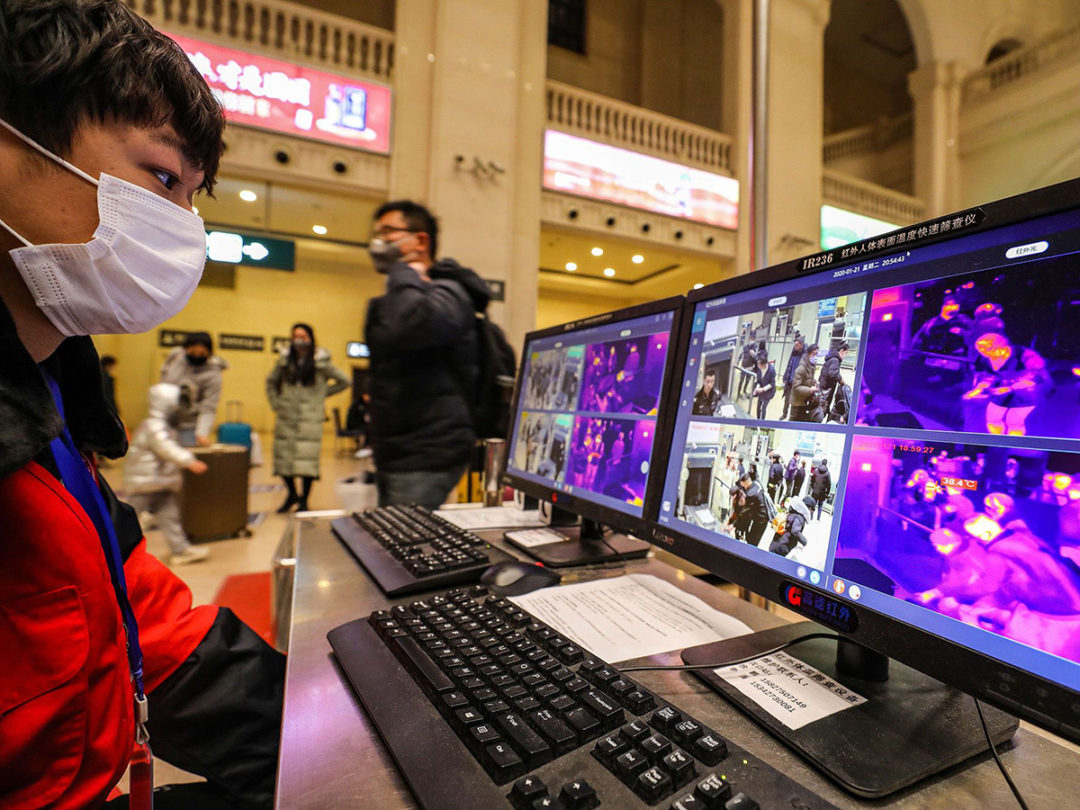
Home » How Thermal Screening Can Help Detect COVID-19 in the Workplace
EDITOR'S Q&A
How Thermal Screening Can Help Detect COVID-19 in the Workplace

July 2, 2020
As the coronavirus pandemic subsides — whenever that might be — businesses will be figuring out how to reopen in a manner that’s safe for employees as well as for customers. One valuable tool is thermal screening technology. In this conversation with SupplyChainBrain Editor-in-Chief Bob Bowman, Andrew Southern, founder and CEO of Invisible Health Technologies, discusses the state of the art of thermal screening, and why even the most effective systems must be supplemented by additional safety measures.
SCB: What types of thermal screening technology are in regular use today?
Southern: There are a couple of different kinds. There are traditional industrial thermal cameras for sensing heat on an engine, that have been repurposed to sense human fever. Then there's a slightly more advanced form which uses a reference box that sets itself to, let's say, 95 degrees, and shines back into the camera. That's slightly more accurate than the industrial thermal cameras, because it has a reference. The most advanced and accurate version is a mass fever screening system [MFSS], which has been built from the beginning to sense human temperatures in public spaces.
SCB: How quickly can it do that for an accurate read?
Southern: In the case of the MFSS, it’s capable of screening people without their having to stop. The sensing happens while they're within view of the camera lens. You can be sensing people for the entire time they're walking down a corridor.
SCB: Is it accurately telling you whether or not those people have a fever?
Southern: What the technology does is sense heat coming off people's skin. Then it does some math to estimate their core body temperature. Different systems have varying levels of accuracy, with the MFSS being the most accurate. It alerts you whenever somebody walks by with a temperature that's been estimated above the limit that the user sets. You can be scanning many people who are below that threshold, and then the one person who's reading higher will walk by, and the alarm goes off.
SCB: Has this technology existed for some time?
Southern: Thermal imaging for sensing human temperatures has been around for a while. Particularly in Asia, where the Omnisense Sentry system was developed in response to a bad outbreak of SARS in Singapore. It’s been operational for over 10 years there. Now we're starting to see this technology being deployed in the U.S., for reasons related to COVID.
SCB: So the technology in use today is pretty much that same as it was back then?
Southern: No, there are enhancements and improvements that have occurred over time. In the case of the Omnisense Sentry, this is their MK4 model. They've had a number of generations prior to this while making improvements to both the sensing and reference technology. The way the system estimates core body temperature has improved over the years.
SCB: Is it widely used in manufacturing and logistics environments today?
Southern: Not at the moment. We're getting there very quickly. People are understanding that in order to help bring a level of safety and confidence to their employees and guests, they need to provide some technologies in the workplace.
SCB: Is there any reason why these environments might be reluctant to deploy the technology?
Southern: There are two tripping points for folks. The first is that they're afraid they could somehow be liable if they implement the technology and somebody comes through who's sick. I'm not a healthcare professional, not a lawyer, but it seems to me that in this new normal, the risk of that liability is secondary to the health and safety of employees and guests at a facility. It's just common sense. If you can deploy something that every day helps keep people a little safer, we should do that.
The second point is that people don't understand the different levels of accuracy with these systems. A lot of my time is spent explaining how the technology works and what the tradeoffs and limitations are, so that they don't have the feeling that this is the solution for a pandemic. It's a tool we can use as part of a larger, broader effort to make sure people are safe.
SCB: Can these systems be prohibitively expensive?
Southern: Some are more expensive than others. The tradeoff is accuracy and speed. If you bought a system for $10,000, you might need everybody to queue up and stop in front of the camera for three seconds to get a reading. If you're trying to process a lot of people arriving for a shift, you might need three or four lanes in order do everybody quickly and not have them waiting forever. You could think about a loss of productivity if you were to do something like that. On the flip side, an MFSS like Omnisense is $30,000, but it can scan everybody without them stopping. You can do the entire thing with no queues, just have people walk by, and you only need one of them.
SCB: Still, I would guess companies might pause for a moment before deciding to adopt something at that level.
Southern: Yes, it's important to educate. There are places that require only the slower system, where it's not necessary to have an MFSS. But then there are larger facilities that absolutely would benefit from a system like that. Once you realize how much productivity you could lose in the morning by queuing everybody up for 15 or 20 minutes, it makes sense to just have them walk through with a more expensive system.
SCB: Other than the potential cost, does the technology as it exists today present any shortcomings or problems with accuracy? Are there any issues to be addressed?
Southern: Yes. There are a couple of important things to keep in mind when you're deploying any thermal camera system. The first is its location within the facility. None of them can sense people when they come right in out of the cold or heat. If it’s a sunny day and you take a reading right when they walk in the door, the camera's going to read that heat on their skin. So we generally advise companies to figure out a way to sense them after about 60 or 90 seconds into the space. What that probably means is that you put the camera a bit further into the lobby of the building.
SCB: Is there room for improvement in the technology? Can it become even more accurate and less intrusive?
Southern: Technology always has the opportunity to improve. We're down to 0.1 degree Celsius accuracy — that's like a third of a degree Fahrenheit — with the Omnisense system, but the technology could ultimately get to 0.1 degrees Fahrenheit of accuracy. There's always going to be a push to make the system more accurate, with a even better algorithm to determine core body temperature, andwith a smaller footprint and less power draw.
SCB: But other measures need to be taken as well?
Southern: Yes. This is one of the tools for helping to ensure people's health, but it's not the only tool, and it shouldn't replace masks, hand sanitizing and social distancing. One of the downsides of the system would be that people might feel overly confident with this one measure in place. It should really be part of a larger effort.
RELATED CONTENT
RELATED VIDEOS
Subscribe to our Daily Newsletter!
Timely, incisive articles delivered directly to your inbox.
Popular Stories

2024 Supply Chain Management Resource Guide: There's Only One Way Off a Burning Platform
VIEW THE LATEST ISSUECase Studies
-
Recycled Tagging Fasteners: Small Changes Make a Big Impact
-

Enhancing High-Value Electronics Shipment Security with Tive's Real-Time Tracking
-

Moving Robots Site-to-Site
-
JLL Finds Perfect Warehouse Location, Leading to $15M Grant for Startup
-
Robots Speed Fulfillment to Help Apparel Company Scale for Growth



